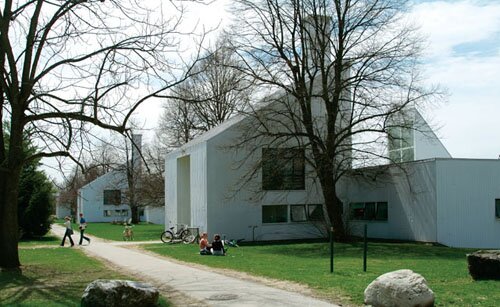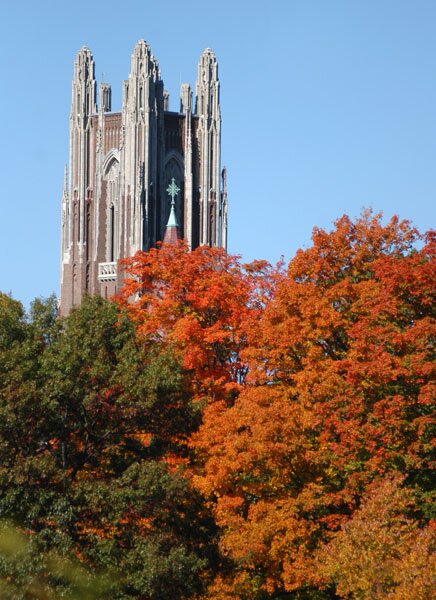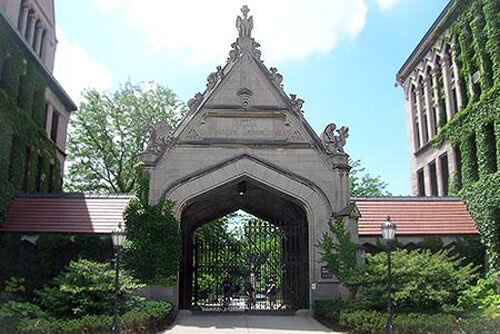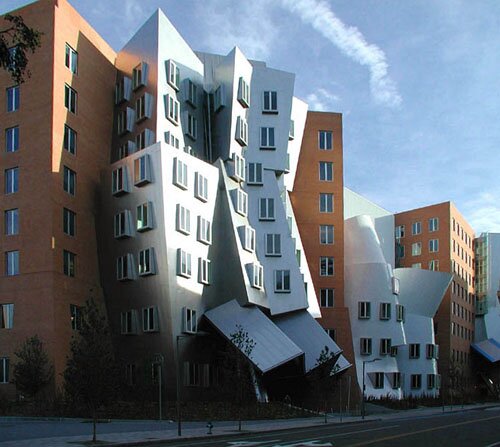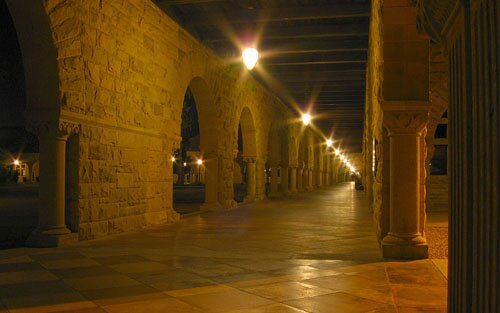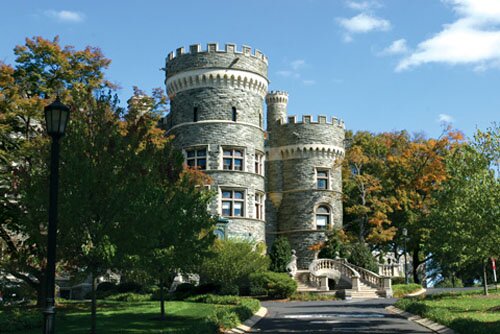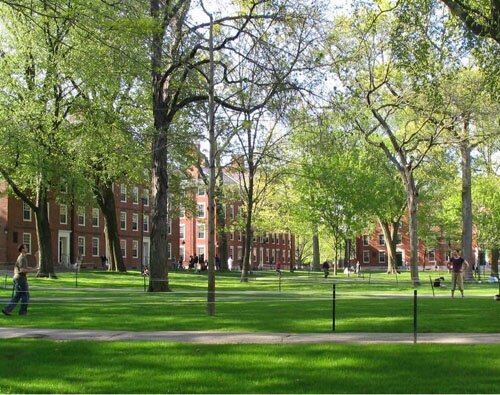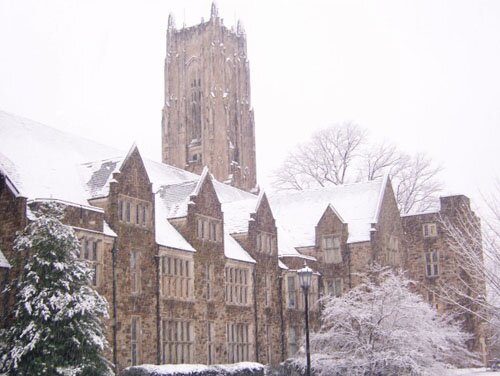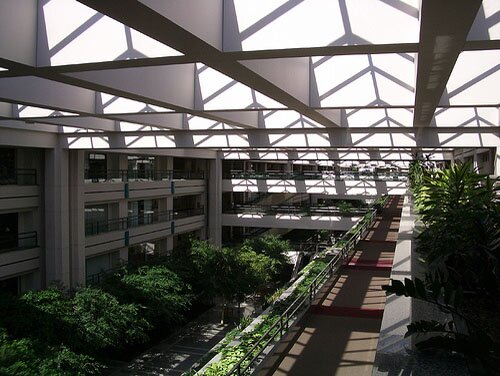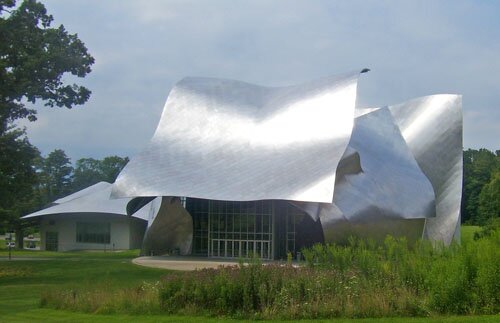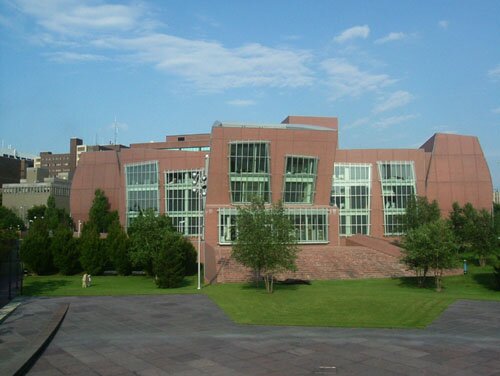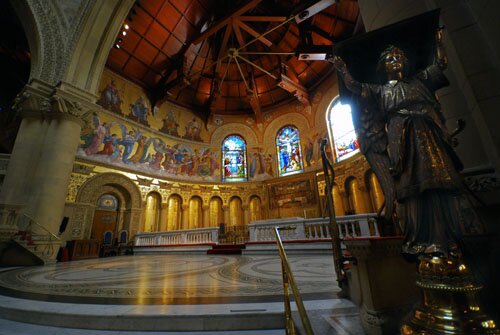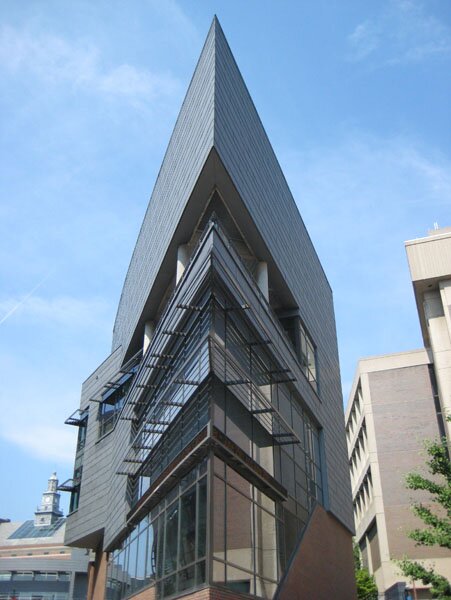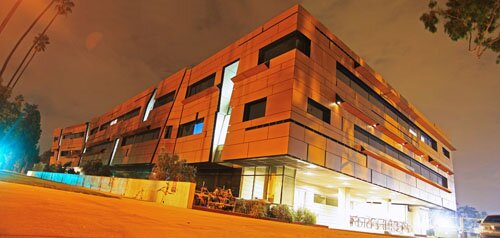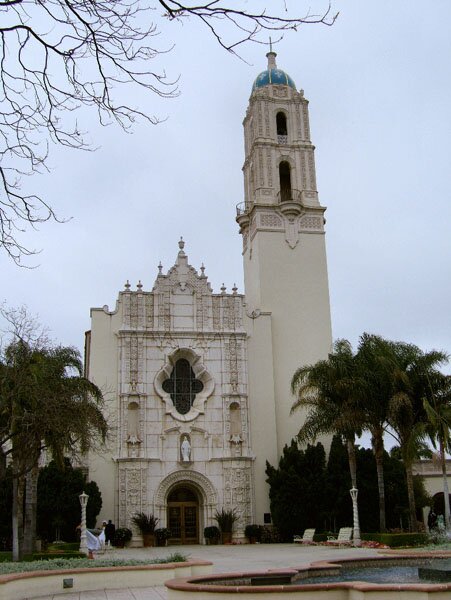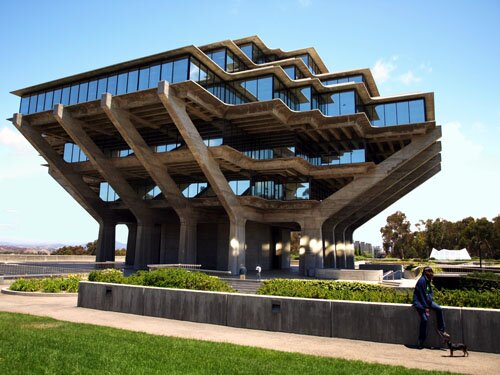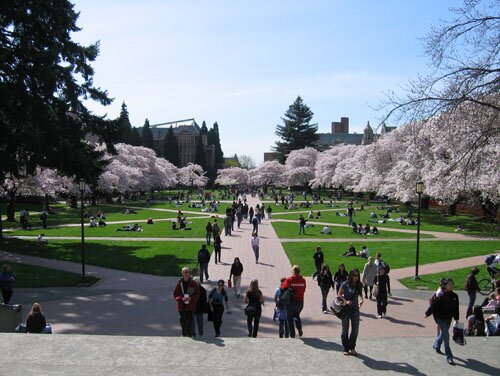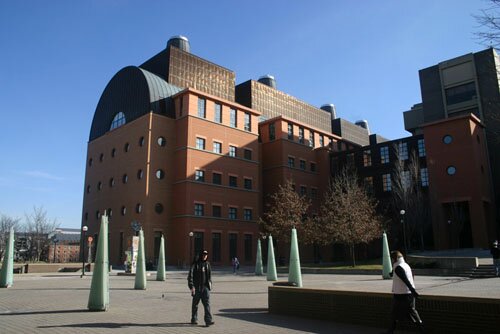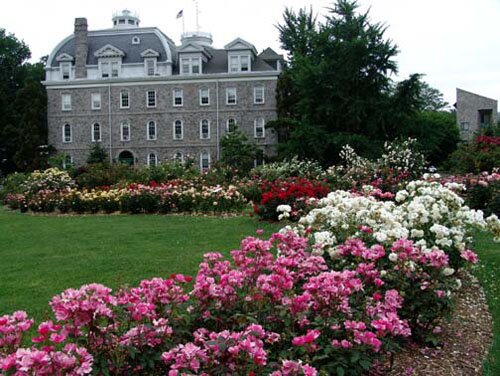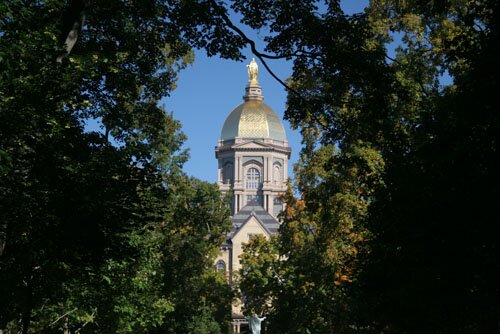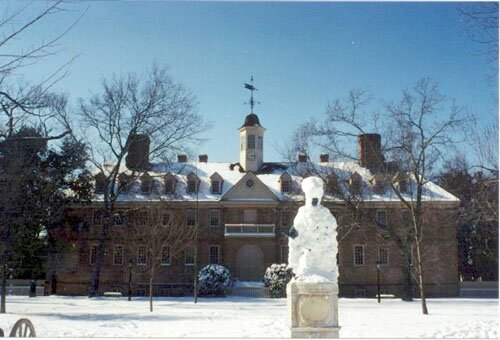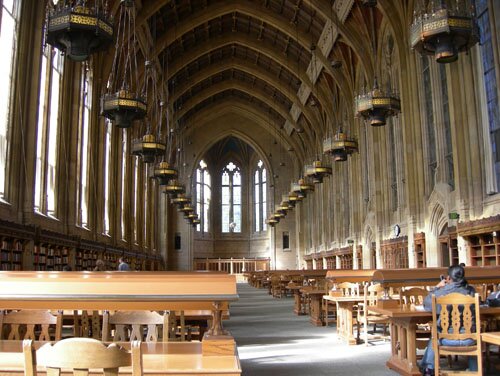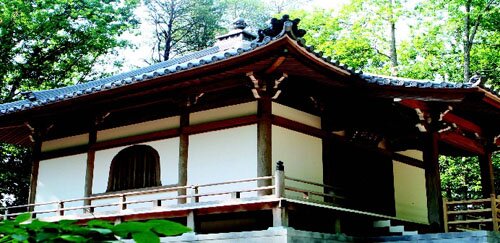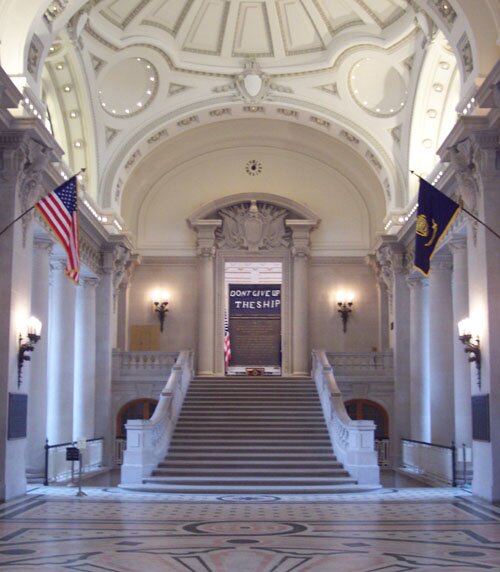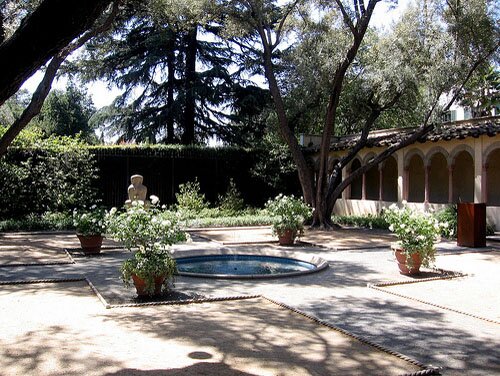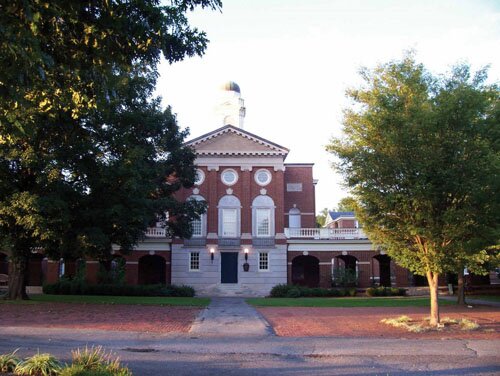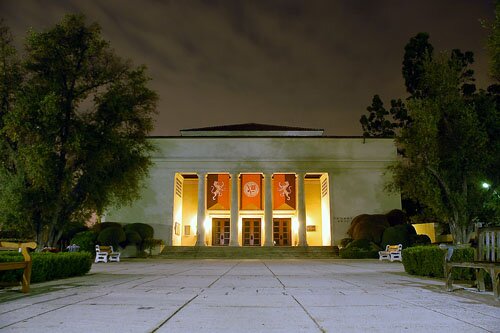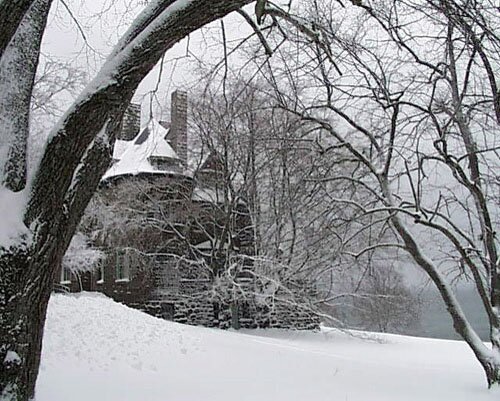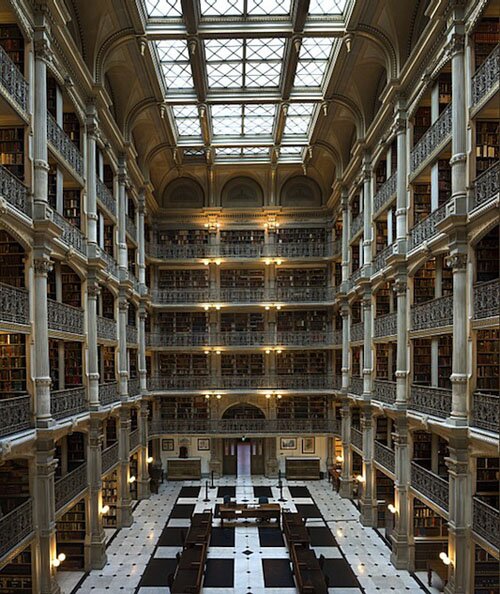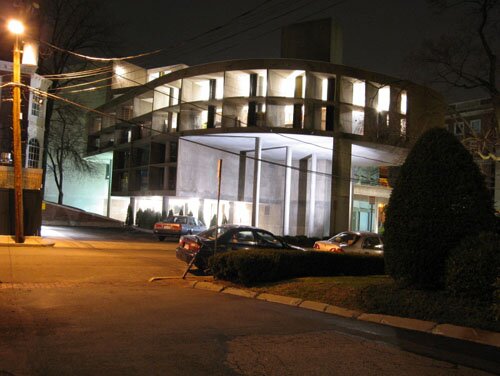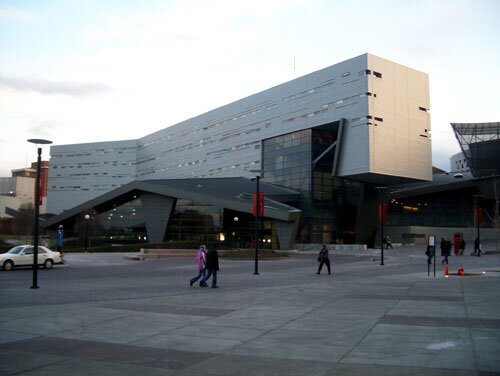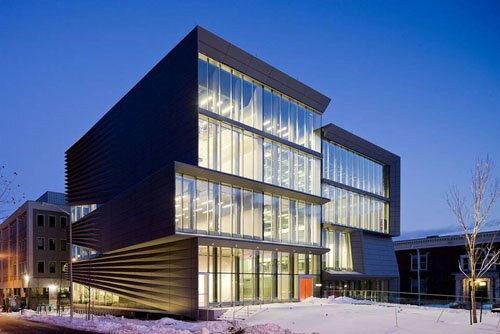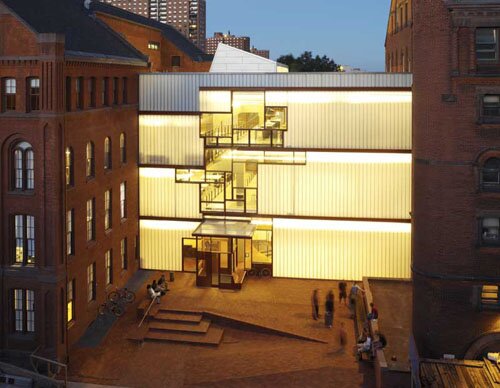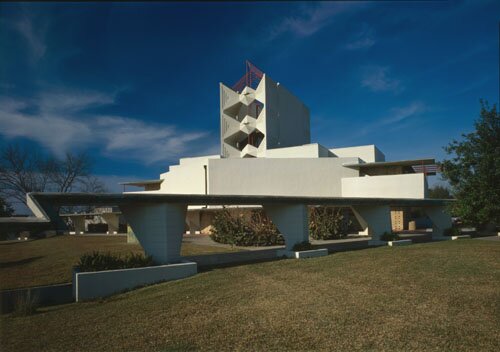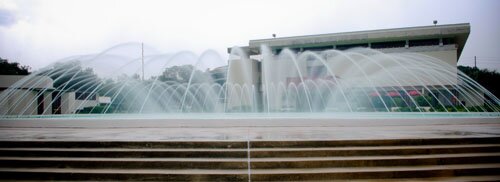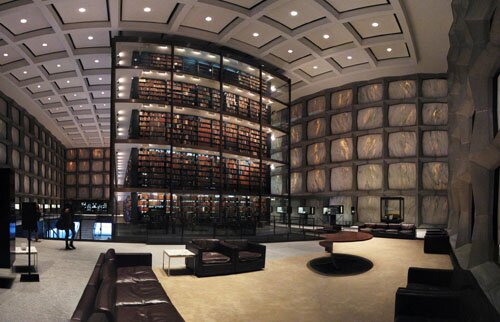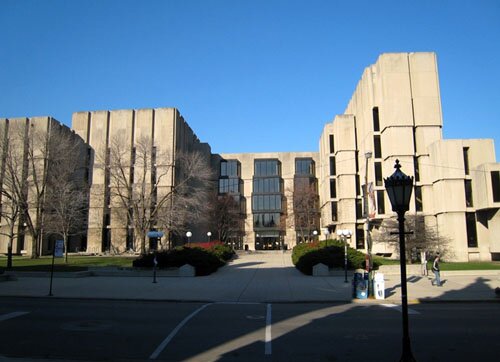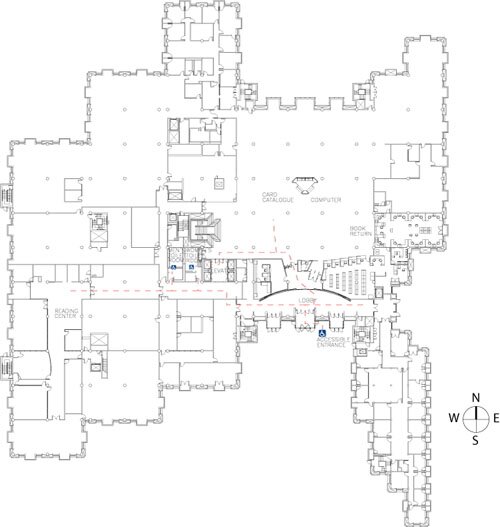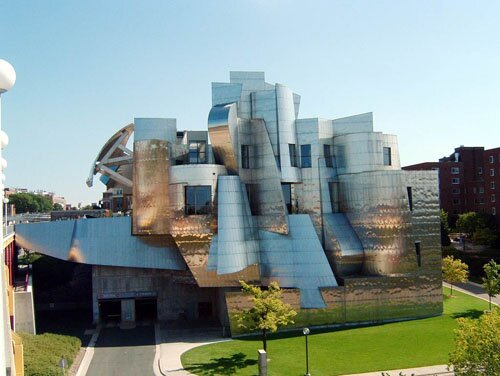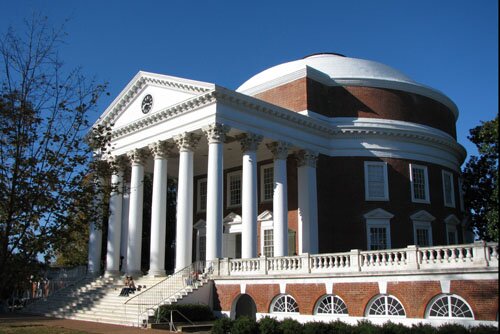
College campuses play a large role in the quality of life of students, and we at Top Colleges Online believe a quality campus plays a significant part in creating a quality learning environment and successful educational experience. Many college campuses are pleasant, but some go a step further and are themselves intellectually stimulating by being interesting architecturally.
Students who love their college campuses report greater overall satisfaction with their college experience, and so we have gathered 50 different examples of awesome college architecture that go a long way towards creating loved college campuses. Within this list lies tremendous opportunity for educational inspiration and memorable college experiences.
50. Bennington College’s Student Housing
Bennington College is a small (and famously expensive) liberal arts college in Vermont. Its student housing is unusual in that rather than dorms, students live in houses. Some are from the 30s when the campus was first opened, but far more interesting are a series that were constructed in the 1970s by Edward Larrabee Barnes. A prominent and award winning architect from the middle of the 20th-century, he’s just one of the many designers that gave their skills to this small college.
49. Wellesley’s Galen Stone Tower
Rising above Wellesley’s Green Hall is the 182-foot high Galen Stone Tower, named for the trustee who funded it. A focal point of the campus, it houses a 32-bell carillon, which is often played by the students at major events. Arguably the most visually striking part of the campus, it’s a classic example of neo-Gothic architecture, and instantly recognizable.
48. University of Chicago’s Main Quad
Where most universities may be content with a simple quadrangle, a four sided hunk of grass surrounded by old buildings, not UC. No, they decided to build a quadrangle at the heart of their college, a quadrangle made up of other, smaller quadrangles. These are the oldest buildings on campus, and the Main Quadrangle is made up of six smaller quadrangles, each surrounded by buildings, bordering one larger quadrangle. Designed in the Collegiate Gothic and Victorian Gothic styles, they were built with the intent to mimic the classic structures of Oxford and Cambridge.
47. MIT’s Ray and Maria Stata Center
There is plenty to dislike about the Ray and Maria Stata Center at MIT. It leaks, the elevators are impossible to get anywhere on, there’s no soundproofing, and it’s incredibly jarring when in context of the rest of the buildings around it. However, it’s also a brilliant and visionary design by one of the most famous living architects, Frank Gehry. Completed in 2004, it’s a bizarre chimera looking building, and cost almost $300 million to build, causing something of an uproar.
46. Stanford’s Main Quad
When Stanford University was first constructed, it was undertaken in the then current Mission Revival style, which is still found throughout California. Designed by Charles Allerton Coolidge, the buildings were generally rectangular in shape, with half-circle arches, red tile roofs, and sandstone masonry. Unfortunately, the great earthquake of 1906 destroyed much of this original architecture, but Stanford’s Main Quad survived, as a legacy of this once classic style.
45. Arcadia University’s Grey Towers Castle
Construction began on Grey Towers Castle in 1893, but it wasn’t until 1929 when it was purchased by what was at that point Beaver College. Now part of Arcadia University, the Castle is an incredible and elegant construction of grey stone. Crafted in a variety of styles, it somehow manages to blend into a seamless whole. It’s a building beloved by the students of the college, and rumored to be crisscrossed with secret passages used for illicit liaisons from its earlier days.
44. Princeton’s University Chapel
You’ll see no shortage of chapels on this list, as religious buildings have always had a flair for the dramatic, even on campuses. The third largest university chapel in the world, this was built in the 1920s at an astonishing cost of $2 million, and is based on the fourteenth century English Gothic style. Built of sand- and lime-stone, it has an extensive array of iconography, crafted of stained glass, stone masonry, and wood carvings.
43. The University of the South’s All Saints Chapel
The chapel at Sewanee was completed in 1959 based on architectural plans that had been drawn up by Ralph Adams Cram in 1904. The design is inspired by numerous famous buildings, including the University Church at Oxford University, Notre Dame de Paris, and the French cathedrals Chartres and Amiens.
42. Harvard University’s Harvard Yard
More than just a shibboleth for anyone who’s been in Massachusetts too long, Harvard Yard is a central component of the life of Harvard University. Harvard is the oldest university in the USA, and Harvard Yard is the oldest part of said University. It’s 25 acres of green grass, surrounded by old buildings and older money and contains thirteen freshman dormitories, four libraries, five buildings of classrooms departments, and the central administrative offices of the Faculty of Arts and Sciences and the university. While not a building in and of itself, it’s iconic nature deserves recognition.
41. Rhodes College’s Palmer Hall
Rhodes College is renowned for its Gothic architecture, to the point where thirteen of its campus buildings are on the National Register of Historic Places. While any number of them will fit on this list, perhaps the most iconic of the lot is Palmer Hall, which was built in 1925, and designed by Henry Hibbs — the man behind many of Princeton’s buildings. In 1962 a 140-foot tower was added to the building, giving it a commanding presence over the entire campus.
40. Loyola Marymount University’s University Hall
Acquired by the university in 2000, University Hall was originally constructed as the world headquarters of Hughes Aircraft. This enormous corporate facility became an immense academic one, with both office and classroom space. It has 500,000-square-feet of space, is constructed of steel and concrete and is divided into seven structures — it even manages to fit the entire Bellarmine College of Liberal Arts inside it. Additionally, there’s a 70,000-square-foot atrium, and plenty of parking.
39. Bard College’s Fisher Center
The Fisher Center, or more accurately, the Richard B. Fisher Center for the Performing Arts, is Frank Gehry design, this time at the small, liberal arts Bard College. The building contains two theaters and four rehearsal studios, as well as all the support facilities required. It’s been called “the best small concert hall in America”, and both of the theaters within are immensely flexible. There’s the 900 seat Sosnoff Theater, which features acoustic design by Yasuhisa Toyota, which can be converted from theater to concert hall. Theater Two holds a much more intimate 200 viewers.
38. University of Cincinnati’s Vontz Center for Molecular Studies
Let’s just put it this way. You can never go wrong with Frank Gehry. This bizarre, almost cartoonish, building is part of the UC medical campus. It’s a panoply of curved lines, skewed windows, tilted angles, making it stand out significantly from other buildings near by. Inside it fits 150,000 square feet of labs, offices and lecture halls. Built around the same time as Gehry’s Guggenheim Museum in Bilbao, it cost a whopping $46 million to construct.
37. Stanford’s Memorial Church
When the Memorial Church at Stanford was dedicated in 1903, it was one of the first non-denominational churches on the West Coast, and remains one of the most prominent to this day. Most obviously marked by an enormous biblical fresco on the front of the building, the church is constructed in a Venetian style, with Byzantine details. The church has four pipe organs, and its eclectic style marks it as a product of the American Renaissance. Unfortunately, time has not been kind to the building, and it has weathered two severe earthquakes, requiring major repair work after each.
36. Notre Dame’s Basilica of the Sacred Heart
While the Main Building may be the most obvious physical feature of Notre Dame, it’s actually less high than the incredible Basilica of the Sacred Heart. The tower of the church stretches an incredible 218 feet into the air, and took 18 years to build from 1870 to 1888. A classic example of neo-gothic architecture, its covered with elaborate decorations including 44 stained glass windows and murals by by Vatican painter Luigi Gregori, and more than 116 stained glass windows overall. In 1992, Pope John Paul II elevated the building from church to basilica, and ensured it remained a major attraction at the school.
35. University of Cincinnati’s Steger Student Life Center
Since the 1990s, University of Cincinnati has pushed to differentiate itself from the competition through architecture, of which there are a great number of absolutely incredible campus buildings designed by modern architects. The Steger Student Life Center was built in 2005 by Moore Ruble Yudell, and houses many of the student organizations on campus. The building itself is like a bizarre and wonderful marriage between a curve and the prow of a ship. Long and thin, it pierces the air around it, while maintaining its own unique form.
34. CalTech’s Cahill Center for Astronomy and Astrophysics
A design by the incredible Morphosis firm, the Cahill Center looks all the world like a building passed through a broken mirror. With dramatic slashes through its outer walls, and areas jutting out at bizarre angles, it should be a painfully incongruous building. It’s not. It stands out, but more from its excellence than anything else. While Morphosis calls this one of their more conservative buildings (a statement that almost makes sense, given its low and long profile), its outside is still remarkable, even more so main internal staircase.
33. University of San Diego’s Immaculata Chapel
The entirety of USD’s architecture is based on the 16th century Spanish Renaissance, of which the chapel is a prime example. The style is specifically modeled on the Universidad de Alcalá in Spain, and while the chapel is no longer an official part of USD, it’s still very much associated with the Catholic university, and a major part of campus life for practitioners of the faith. The Plateresque style is incredibly ornate, and is an evolution of Gothic detail and forms, and is primarily noted for its ornate decorative facades, covered with flowers, creatures, and other carvings.
32. UCSD’s Geisel Library
The Geisel Library is named in honor of Theodor Geisel — a man better known to you and me as Dr. Seuss. That’s right, UCSD has a Dr. Seuss library — and while it’s not quite as bizarre as you’d assume a library named after the famed absurdest children’s illustrator would be, it’s still a remarkable looking building. So much so, in fact, that it’s featured on UCSD’s logo. It has a remarkable shape, with its middle floor the largest, and comparatively tiny lower and upper levels, and easily the most recognizable on campus.
31. University of Washington’s Quad
Practically every University in existence has a quad, so what in the world makes this one special? The trees. In 1964, some 40 cherry trees were moved to the Quad, and every spring when the cherry blossoms show, it’s a major deal. For a scant two weeks, the Quad becomes covered in a haze of pink petals, an annual event that has become a major part of the University. Unfortunately, the 30 trees are all more than 60 years old, and well into the end of the natural lifespan of the species — which raises questions about what the University will do as they start to die.
30. University of Cincinnati’s Engineering Research Center
Designed by UC alum Michael Graves, and built in 1994, the Engineering Research Center’s design inspiration is far more immediate than many on this list. It’s designed to look like a four-cylinder engine. Built using traditional methods and forms, it sits at a busy pedestrian intersection. Just looking at it, it’s a far more solid and almost brutalist form than many of the other modern designed buildings, an eminently pragmatic building in space and form.
29. Swarthmore’s Dean Bond Rose Garden
Across the campus of Swarthmore lies the Scott Arboretum, 357 acres comprised of 4,000 species of ornamental plant, all open free to the public. Yet by far the crowning jewel in this already impressive collection is the shockingly gorgeous Dean Bond Rose Garden. Housing 650 roses of more than 200 types, it was established in memorial of Elizabeth Powell Bond, the Dean of Women at Swarthmore. It’s now tradition for graduating seniors of the college to pin a rose on their gown for commencement.
28. Yale’s Ingalls Rink
Designed by Eero Saarinen, the Ingalls rink is exactly what you would guess from its name — a hockey rink. An unusual structure to put such a modern design into, it was built in the 1950s for $1.5 million — double its original estimate. Due to its undulating and wide appearance, it’s commonly likened to a whale in form, and can squeeze 3,500 inside. It’s had to have substantial renovations twice — once in 1991 for $1.5 million, and then from 2007-2009 for $23.5 million. While doubtless an unusual looking sports arena, it’s a widely recognized and respected building, making it onto America’s Favorite Architecture list, by the American Institute of Architects.
27. Notre Dame’s Main Building
Notre Dame is one of the most widely known religiously affiliated universities in the USA, and much of its architecture celebrates the institutions link to the Catholic Church. Perhaps the most obvious example of this is the Main Building, which is topped with an enormous gold dome, above which is a huge statue of the Virgin Mary. This immense building is now used primarily for administration purposes, but was once, unsurprisingly, the main building of the campus. Built in 1879, the dome was added in 1882, and regilded in 2005.
26. College of William and Mary’s Wren Building
The Wren Building holds the title of the oldest academic building in continuous use, which was constructed in 1700. That’s right, it’s been used for 300 years, and has suffered several fires and subsequent rebuilding, but most famously was reconstructed by John D. Rockefeller, Jr., as part of the Colonial Williamsburg restoration in the 1920s. It’s constructed of red brick in the Flemish Bond style, and is as a historic building as you’re likely to find in the USA. Grand and ancient, it’s a true classic.
25. University of Washington’s Suzzallo Library Graduate Reading Room
Named for university president Henry Suzzallo, the Suzzallo library was completed in 1926, a stunning example of Collegiate Gothic style. Inside, the most visually striking area is the graduate reading room, feeling for all the world like the inside of a church. It’s 50-foot long, 52-foot wide, 65-foot high, with stone walls, a painted and stenciled timber-vaulted ceiling, and stained glass windows recreating a painted and stenciled timber-vaulted ceiling. It spans the entire third floor of the west face of the library, and was explicitly modeled on cathedrals.
24. Furman University’s Buddhist Temple
There are a number of chapels and churches on this list, but so far all are Christian of one sort or another. Unusually, Furman University of South Carolina has a Buddhist temple as part of its grounds. It’s part of an Asian garden, and the temple itself was moved from Japan and reconstructed by traditional carpenters. The Place of Peace, as it’s known, only became part of the campus in 2008. It’s hard to imagine a structure more dissimilar to the enormous neo-Gothic chapels of some campuses, yet you can’t deny the beauty of this small, unassuming, and simple temple.
23. Lewis and Clark’s Frank Manor House
Lewis and Clark College is widely renowned for its incredibly gorgeous campus, due to its sprawling woodlands feel in the hills of Portland. With a major emphasis on sustainability and an environmental bent, it’s very much in the tradition of the Pacific Northwest. Of all the buildings on this gorgeous campus, none are as well known as the Frank Manor House. It now serves as an admissions and administration building, but was originally constructed as a private residence in 1926 for an astonishing $1.3 million — and the college were allowed to purchase it for just $42,000. A stunning example of early-20th century design, it’s still visually striking.
22. United States Naval Academy’s Bancroft Hall
The United States Naval Academy isn’t one to do things by halves. Its buildings are immense, and grandiose in the greatest neo-classical tradition of American monumental architecture. There’s no better example of this than Bancroft Hall, the largest dormitory in the world. It houses 4,000 midshipmen in 1,700 rooms, has 33 acres of floorspace, and almost 5 miles of corridors. It’s a classic example of American Beaux-Arts architecture, and is so large it even has its own zip code.
21. Claremont’s Scripps College
It’s impossible to note a single building at the all-women Scripps College as being of particular note, as the entire campus was built under a single aesthetic. Designed by Gordon Kauffman, every building is constructed in the Spanish Colonial Revival Style style. Intertwined with the tiled roofs and small pillars is the incredible landscaping, which artfully mixes gardens into the college lifestyle. Students are allowed to clip roses from bushes, and fruit trees cover the campus. Famously beautiful, the entire small campus resonates.
20. Sweet Briar College’s Pannell Center
An astonishing twenty-one of the 30 campus buildings at Sweet Briar College are listed on the National Historic Registrar, which gives a hint at just how historically important this campus is. Formerly the refectory, what is now the Anne Gary Pannell Center is one of the four original buildings on campus, first constructed in 1906. Designed by Ralph Adam Cram, it’s one of his rare collegiate Georgian Revival buildings. Now home to the art history department, an art gallery and art library, what was once a dining hall remains an incredible piece of architecture.
19. Occidental College’s Thorne Hall
Many of Oxy (as it’s known) original buildings were built in a Mediterranean style, a hardly surprising fact for Southern California. The original three buildings were constructed in 1914, and the rest of the campus followed the same architectural tradition, and none more noticeably than Thorne Hall. Erected by Charles H. Thorne in memory of his wife in 1938 and remodeled in 1989, it seats almost 800 people, as well providing much of the performance and rehearsal space for the music department. It even contains a pipe organ purchased from the Empire Hotel in San Francisco, and rebuilt in the hall.
18. College of the Atlantic
In general, I’ve avoided saying things about an entire campus on this list, as it’s a copout when looking for fantastic individual buildings. Even so, I think the College of the Atlantic deserves special mention in its entirety. This tiny, liberal arts college in Maine has fewer than 400 students, and only offers one degree: human ecology. The entire college is based on sustainability, and the campus reflects that. It was the first carbon neutral campus. Since it’s on a tiny island, it’s impossible to escape the grasp of the surrounding sea, which informs much of the architecture and student life. Its buildings are eclectic, ranging from cottages to a converted monastery.
17. University of Chicago’s Harper Library Reading Room
There’s an incomparable beauty in old libraries, quiet refuges of sanity and knowledge. At many great universities, the library was given as much architectural attention as any chapel, for instance the recently renovated reading rooms in the Harper Memorial Library at University of Chicago. The renovations transformed the threadbare carpet and ratty chairs into a newly refitted, but still historically respectful, space, which became a massively popular study spot amongst the students.
16. University of Michigan’s Law Library
When the University of Michigan decided they wanted to expand their law library, they were faced with an interesting challenge. The Law Quad was a historical and classic space, they were loathe to expand into and disrupt with modern buildings. The answer? Build down. Now the law library features several floors of standard library stacks; and incredible neogothic reading room with 50-foot ceilings and stained glass windows; and then he Allan F. and Alene Smith Library, which was constructed underground in 1981. Through the use of a massive skylight build into the quad, a huge amount of natural light filters down into what could otherwise be an incredibly dark and dingy space.
15. Illinois Institute of Technology in Chicago’s S.R. Crown Hall
It’s impossible to wax too lyrical about Crown Hall. The home of IIT’s college of architecture, it was designed by the famed modernist architect Ludwig Mies van der Rohe, and is viewed as his masterpiece. Widely regarded as one of the most important buildings in the 20th Century Modernist movement, it’s shocking to think this aggressively modern building is now more than 50 years old. The building’s design is based around simplicity, with exposed steel frames, and large sheets of glass. Transparent in every sense of the word, it’s a triumph of modern design.
14. Illinois Institute of Technology’s McCormick Tribune Campus Center
Constructed in 2003, the McCormick building was the first structure designed by Rem Koolhaas to be built in the USA. It’s a a single-story 110,000-square-foot, which took the place of a former parking lot. Koolhaas tracked the way students walked across the lot, and created a design to best match the way they moved through the space. One of the major problems he faced was that the Green Line train passed right over the building, so in order to minimize noise, an immense stainless steel tube was constructed for the train to drive through, dampening the sound.
13. Johns Hopkins University’s George Peabody Library
The Peabody Institute was donated by the famous philanthropist George Peabody in 1857, and as part of that the library was constructed in 1878, and its design remains striking to this day. Home to an incredible number of Victorian tomes, it’s interior is comprised of five levels, each of which bears ornamental internal balconies, stretching up to a skylight in the middle. Perhaps best described as a “cathedral of books”, it was built in the neo-Grec style, and soars 61 feet in the air.
12. Harvard University’s Carpenter Center for the Visual Arts
The Carpenter Center for the Visual Arts is the only building actually built by famed French designer Le Corbusier in the USA. One of the fathers of modernism, his designs are extremely important for the entire modernist architecture movement, and even though he didn’t see the building before his death, this 1962 construction remains eminently important. These days it not only houses the department of Visual and Environmental Studies of the University, but also the Harvard Film Archive, as well as screening films.
11. University of Cincinnati’s Campus Recreation Center
Thom Mayne and his company Morphosis are genuinely amazing architects, and their 350,000 square foot campus rec center at UC is no exception. This center is a chimera of a building, a structure made of a number of different styles, slammed together in an almost terrifying way. A combination of lecture theaters, dorms, and a gym, each of these areas has a different feel, which are then combined into one amazing, if slightly schizophrenic building.
10. Brown University’s Granoff Center for the Creative Arts
The Granoff Center only opened in January of 2011, designed as a space “for collaboration between and among the arts, sciences, and humanities.” Designed by Diller Scofidio + Renfro, it’s an incredible 38,815 square-foot, three-story building, which cost $40 million to build. Cut from shear lines, and making heavy use of glass, it houses auditoriums, production studios, audio studios, art gallery, media lab, multimedia lab, and even an outdoors amphitheater wired for sound.
9. Pratt Institute’s Higgins Hall
Higgins Hall looks for all the world like a stately brownstone building one would expect of any college, but a recent renovation by architect Steven Holl has proven it anything but. Higgins houses an architecture school, and it seems only appropriate that an entirely modern and radically different shape should be married to such a classic building. The newly inserted hall looks almost like a series of shipping containers stacked atop one another, if the containers were made of translucent glass. Combined with windows that echo the works of Mondrian, it’s a radical new extension on the existing space.
8. Florida Southern College’s Annie Pfeiffer Chapel
Florida Southern College isn’t a big or well known institute, with just 2400 students and 100 teaching staff. What it does have, though, is the largest collection Frank Lloyd Wright architecture in the world, a collection strong enough to propel it to the top of the Princeton Review’s most beautiful campuses list. The collection as a whole is known as Child of the Sun, and one of its key structures is the Annie Pfeiffer Chapel, which was dedicated in 1941. The chapel was the first building on campus, and constructed with student labor, and has become a hallmark of the college.
7. Emory University’s Pitts Theology Library
One of the largest and most important theological libraries in the world, Pitts features not only an impressive collection of manuscripts, but also an amazing digital image archive. One would assume that a theology library would be like so many other entries on this list, and immense neo-gothic structure in the Oxbridgian tradition. Instead, what it is is a magnificent southern building constructed in 1916, but that underwent a series of renovations in the 50s, 60s, and 70s, and transformed into an amazing modernist space. The exterior is still constructed of rare pink Georgia marble, but the inside is one of the few examples of non-brutalist work done by Paul Rudolph. It’s a harmony of glass, right angles, and half circles, and is a gorgeous space.
6. Florida Southern College’s Water Dome
The other most notable FSC Lloyd Wright structure is the Water Dome, which was partially completed in 1949, but only fully finished to Wright’s specifications in 2007. Wright originally planned the dome to be a centerpiece of the college, but the water pump technology of the time wasn’t powerful enough to live up to his dreams. When it was reconstructed in 2007, his creation was finally realized, 74 jets making a dome water 45 feet high, illuminated droplets spreading over a 160-foot base. While visually less obviously architectural and striking than some of this other work, it’s amazing to see his plans finally realized.
5. New York University’s Department of Philosophy
The exterior of the Department of Philosophy looks just like any other old, big building, a frankly pedestrian site amongst the architecture of New York City. But in 2007 the interior of the building was gutted and remade, into something completely unlike any other. Playing with natural light in a frankly insane way, the interior is now white, and covered with randomly placed small holes, which allows illumination to stream throughout. Coupled with prismatic film, skylights, and cork floors, it’s a monument to natural illumination.
4. Yale’s Beinecke Rare Book and Manuscript Library
It’s hard not to wax lyrical about Beinecke, both in form and function. One of the foremost collections of rare manuscripts in the world, it’s the largest building in the world reserved exclusively for the preservation of rare books and manuscripts. It has an absolutely incredible collection of works, but is just as memorable for its architecture. The building itself is entirely windowless, instead constructed of translucent Danby marble. This allows some light to come through, but nothing direct or harsh enough to damage the collection. The interior is a masterwork of glass and low light, these priceless pieces protected in a beautiful location designed not only to keep them safe, but to allow them to be studied.
3. University of Chicago’s Regenstein Library
Brutalism as an architectural style is one that is all too prevalent at universities, which generally hire incompetent architects to design them. They end up with squat, brooding hulks of buildings, made of dour concrete slabs that have no beauty or art. The Regenstein Library at UC is an example of brutalism done right. It’s built of grooved limestone, and the exterior was explicitly created to mimic the spines of books (one of the few architectural flourishes brutalism can pull off). It holds almost 8 million volumes, and is one of the largest libraries in the world, and even more curiously, the outline is that of the continental USA.
2. University of Minnesota’s Weisman Art Museum
The Weisman Art Museum is located on the University of Minnesota campus, and it only takes a single look to recognize Frank Gehry’s unique style. Completed in 1993, it has a stainless steel skin, especially built for Gehry’s designs, and is a major campus landmark. In October 2010, work started on an addition to the building, also by Gehry, and one year later, the building reopened now with even more space for its incredible collection.
1. University of Virginia’s Rotunda
How can I put this succinctly…the Rotunda at the University of Virginia was designed by Thomas Jefferson. Frankly, if that isn’t enough of a reason on its own, I don’t know what is. Modelled on the Pantheon of Rome, Jefferson designed it to represent the “authority of nature and power of reason” — precisely the attitude one would expect from a post-enlightenment leader. It’s one of only three buildings in the USA protected as a World Heritage Site by UNESCO, and has been through several major rebuildings and refurbishments, and in 1976 was rebuilt to Jefferson’s original specifications.

